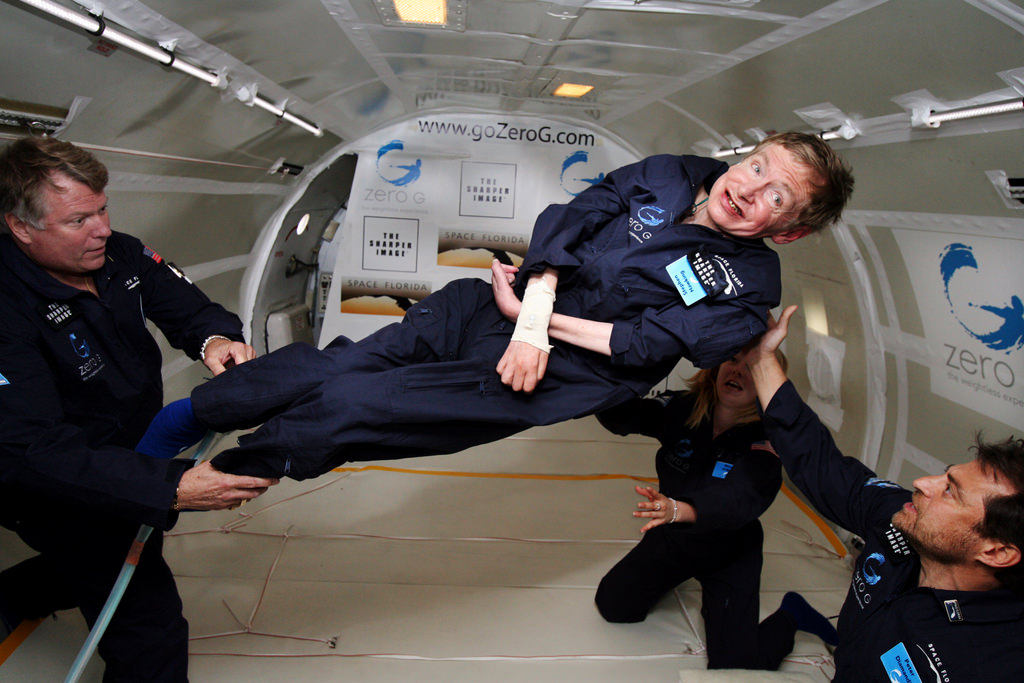Host: Fraser Cain
Guests: David Dickinson, Matthew Francis, Casey Dreier, Sondy Springmann
Continue reading “Weekly Space Hangout – December 6, 2013 – Zombie ISON, Jade Rabbit, Lovely Venus and Naked-Eye Nova”
Subaru Telescope Captures the Fine Details of Comet Lovejoy’s Tail
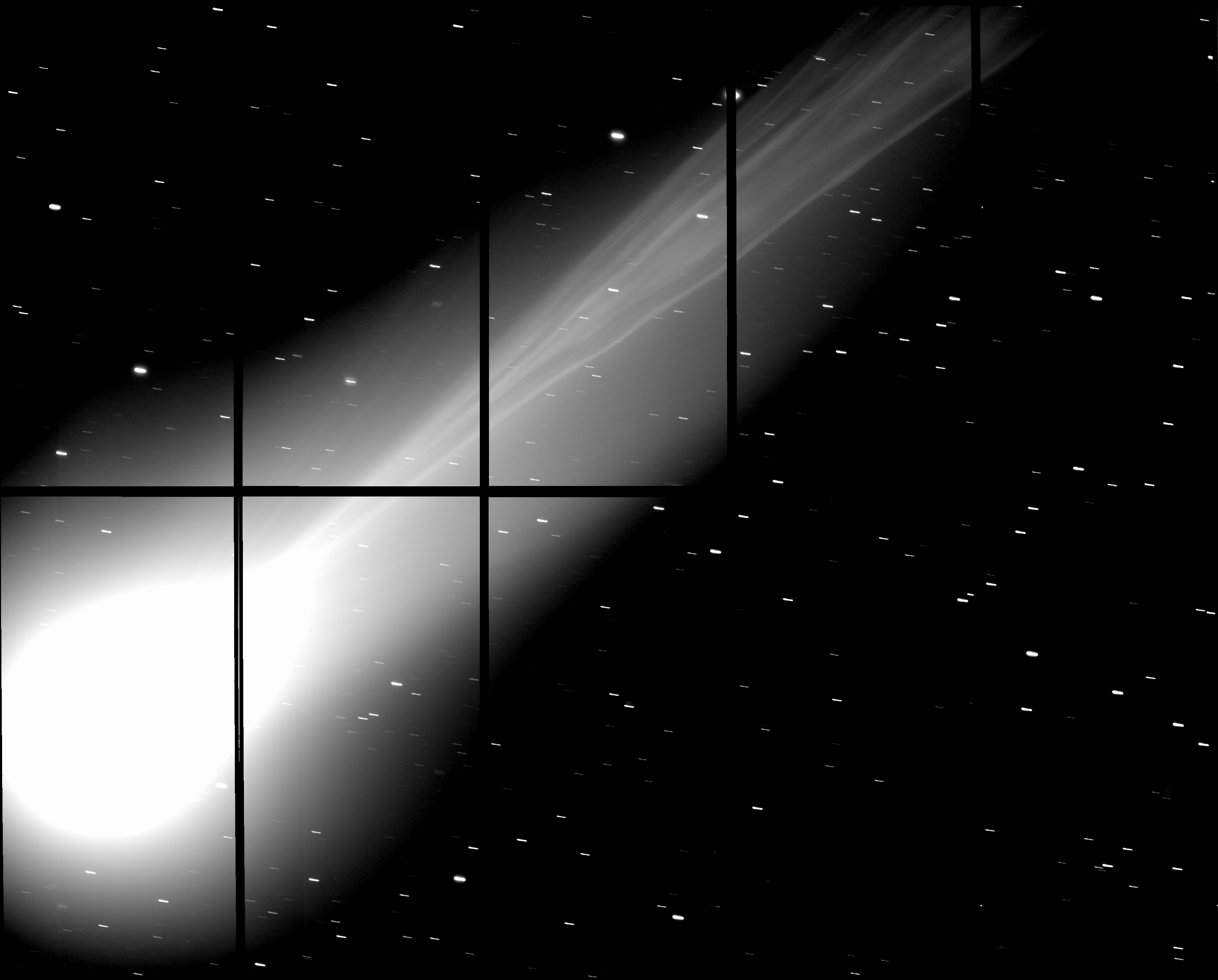
Comet ISON may be no more than just a cloud of icy debris these days but there’s another comet that’s showing off in the morning sky: C/2013 R1 (Lovejoy), which was discovered in September and is steadily nearing its Christmas Day perihelion. In the early hours of Dec. 3, astronomers using the 8.2-meter Subaru Telescope atop Mauna Kea in Hawaii captured this amazing image of Lovejoy, revealing the intricate flows of ion streamers in its tail. (Click the image above for extra awesomeness.)
According to a news story on the NAOJ website:
At the time of this observation, at around 5:30 am on December 3, 2013 (Hawaii Standard Time), Comet Lovejoy was 50 million miles (80 million km) distant from Earth and 80 million miles (130 million km) away from the Sun.
The entire image of comet Lovejoy was made with the Subaru Telescope’s Suprime-Cam, which uses a mosaic of ten 2048 x 4096 CCDs covering a 34′ x 27′ field of view and a pixel scale of 0.2”.

“Subaru Telescope offers a rare combination of large telescope aperture and a wide-field camera,” said a member of the observation team, which included astronomers from Stony Brook University in New York, Universidad Complutense in Madrid, Johns Hopkins University, and the National Astronomical Observatory of Japan. “This enabled us to capture a detailed look at the nucleus while also photogenically framing inner portions of Comet Lovejoy’s impressive ion tail.”
Comet Lovejoy is currently visible in the early morning sky as a naked-eye object in the northern hemisphere.
Read more about Lovejoy’s journey through the inner solar system in this article by Bob King here.
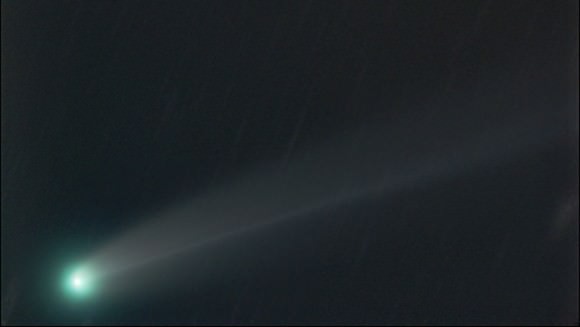
Do you have photos of comet Lovejoy or any other astronomical objects to share? Upload them to the Universe Today Flickr group!
Zot! Curiosity Punches Laser Hole No. 100,000 On Mars
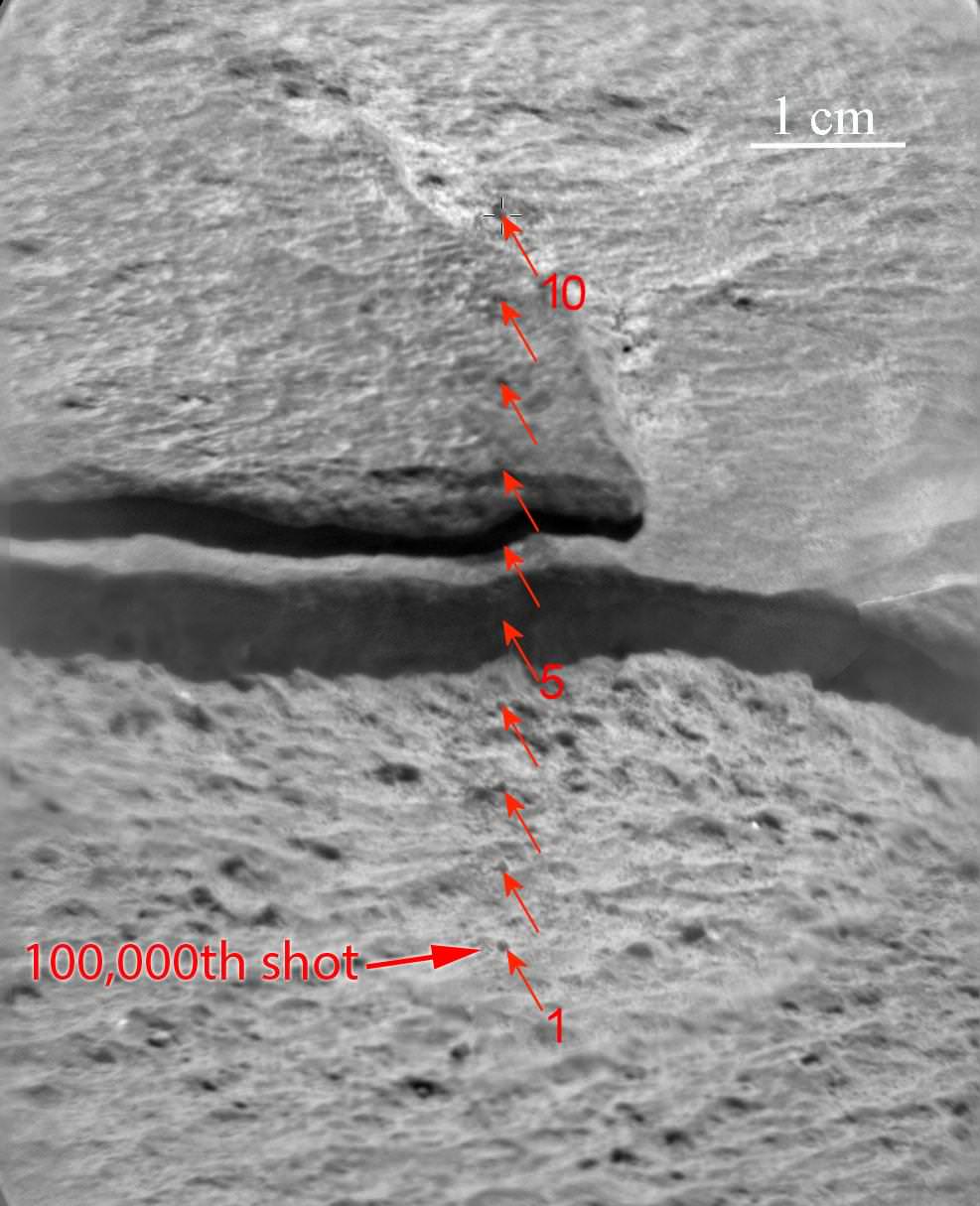
The reports are in: it appears that Earth has the upper hand in firing laser shots on Mars. More seriously, however, the Curiosity rover has surpassed the uber-cool milestone of shooting 100,000 holes in the Red Planet’s surface to learn more about its chemical composition.
As you can see in the picture, the 100,000th shot took place on a rock nicknamed “Ithaca” on Oct. 30 from a distance of 13 feet, 3 inches (4.04 meters) away. (The news was just announced recently; as of early December, the laser had fired more than 102,000 times).
“The Chemistry and Camera instrument (ChemCam) uses the infrared laser to excite material in a pinhead-size spot on the target into a glowing, ionized gas, called plasma. ChemCam observes that spark with the telescope and analyzes the spectrum of light to identify elements in the target,” NASA stated.
This Exoplanet Is Turning Planetary Formation Scenarios Upside Down

What the heck is that giant exoplanet doing so far away from its star? Astronomers are still trying to figure out the curious case of HD 106906 b, a newly found gas giant that orbits at an astounding 650 astronomical units or Earth-sun distances from its host star. For comparison, that’s more than 20 times farther from its star than Neptune is from the sun.
“This system is especially fascinating because no model of either planet or star formation fully explains what we see,” stated Vanessa Bailey, a graduate astronomy student at the University of Arizona who led the research.
HD 106906 b is 11 times the size of Jupiter, throwing conventional planetary formation theory for a loop. Astronomers believe that planets gradually form from clumps of gas and dust that circle around young stars, but that process would take too long for this exoplanet to form — the system is just 13 million years old. (Our own planetary system is about 4.5 billion years old, by comparison.)
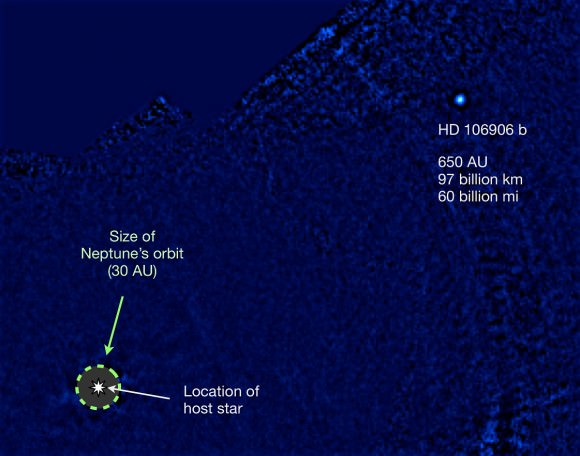
Another theory is that if the disc collapses quickly, perhaps it could spawn a huge planet — but it’s improbable that there is enough mass in the system for that to happen. Perhaps, the team says, this system is like a “mini binary star system”, with HD 106906 b being more or less a failed star of some sort. Yet there is at least one problem with that theory as well; the mass ratio of the planet and star is something like 1 to 100, and usually these scenarios occur in ratios of 1 to 10 or less.
“A binary star system can be formed when two adjacent clumps of gas collapse more or less independently to form stars, and these stars are close enough to each other to exert a mutual gravitation attraction and bind them together in an orbit,” Bailey stated.
“It is possible that in the case of the HD 106906 system the star and planet collapsed independently from clumps of gas, but for some reason the planet’s progenitor clump was starved for material and never grew large enough to ignite and become a star.”
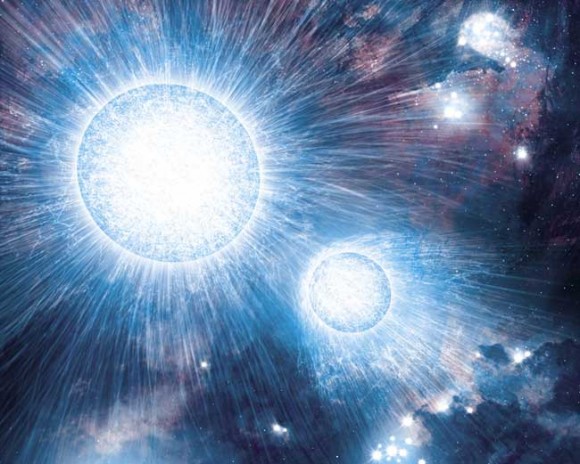
Besides puzzling out how HD 106906 b came to be, astronomers are also interested in the system because they can clearly see leftovers or a debris disk from the system’s formation. By studying this system further, astronomers hope to figure out more about how young planets evolve.
At 2,700 degrees Fahrenheit (1,500 degrees Celsius), the planet is most easily visible in infrared. The heat is from when the planet was first coalescing, astronomers said.
The astronomers spotted the planet using the Magellan telescope at the European Southern Observatory’s Atacama Desert in Chile. It was visible in both the Magellan Adaptive Optics (MagAO) system and Clio2 thermal infrared camera on the telescope. The planet was confirmed using Hubble Space Telescope images from eight years ago, as well as the FIRE spectrograph on Magellan that revealed more about the planet’s “nature and composition”, a press release stated.
The research paper is now available on the prepublishing site Arxiv and will be published in a future issue of Astrophysical Journal Letters.
Source: University of Arizona
Subaru Telescope Reveals Orderly Massive Galaxy Evolution

Nobody likes a sloppy COSMOS (Cosmological Evolution Survey) and astronomers utilizing the Fiber-Multi-Object Spectrograph (FMOS) mounted on the Subaru Telescope have put order into chaos through their studies. The survey has found that some nine billion years ago galaxies were capable of producing new stars in a fashion as orderly as game of checkers. Despite their young cosmological age, the galaxies show signs containing high amounts of dust enriched by heavier elements – a mature state.
“These findings center on a major question: What was the universe like when it was maximally forming its stars?” says John Silverman, the principal investigator of the FMOS-COSMOS project at the Kavli Institute for the Physics and Mathematics of the Universe (Kavli IPMU).
These “universal” questions are just what the COSMOS team seeks to answer. Their research goals are to enlighten the scales of cosmic time in relationship with the environment, formation and evolution of massive galactic structures. When studying individual galaxies, they may be able to tell if their rate of growth can be attributed to large-scale environments. Information of this type can clarify what factors the early Universe structure may have contributed to the current form of local galaxies. One of the data sets the team is focusing on is using the FMOS on the Subaru Telescope to chart out the distribution of more than a thousand galaxies which formed over nine billion years ago – a time when the Universe was hitting its star-formation peak.
“One key to generating fruitful results is collaboration between COSMOS researchers to maximize optimal use of FMOS.” Silverman continues, “In this project, researchers from Kavli IPMU in Japan and the Institute for Astronomy at the University of Hawaii (principal investigator: David Sanders) formed an effective collaboration to implement their goal.” The observations spanned 10 clear nights starting in March 2012.
Why choose spectroscopy? This advanced fiber optics technology speaks for itself, collecting light over an area of sky equal in size to that of the Moon. The FMOS focuses on the near-infrared, filtering out unwanted emissions caused by warm temperatures and can acquire spectra from 400 galaxies simultaneously with a wide field of coverage of 30 arc minutes at prime-focus. By employing such a wide field of view, astronomers can squeeze in a wide range of objects in their local environments. This enables researchers to maximize information on star-forming regions, cluster formation, and cosmology.
As David Sanders, the principal investigator of the FMOS-COSMOS project at IfA, puts it, “FMOS has clearly revolutionized our ability to study how galaxies form and evolve across cosmic time. It is currently the most powerful instrument we have to study the large numbers of objects needed to understand galaxies of all sizes, shapes and masses — from the largest ellipticals to the smallest dwarfs. We are extremely fortunate that the Kavli IPMU-IfA collaboration is giving us this unique opportunity to study the distant universe in such exquisite detail.”
FMOS will soon be famous by revealing its true potential. It has been collecting copious amounts of data in a high spectral resolution mode and at a very successful rate. So far it has accomplished nearly half of its goal – to examine over a thousand galaxies with redshifts to map the large-scale structure. The current survey consists of mapping an area of sky which spans a square degree in high-resolution mode and future plans for FMOS will involve enlarging the area. This expanded coverage will complement other instruments on alternative telescopes which have a wider spectral imaging system or a higher resolution which is limited to a smaller area. These combined findings may one day result in showing us some of the very first structures that eventually evolved into the massive galaxy clusters we see today!
Original Story Source: Kavli Institute for the Physics and Mathematics of the Universe News Release.
Astrophoto: Star Trails Over Kitt Peak
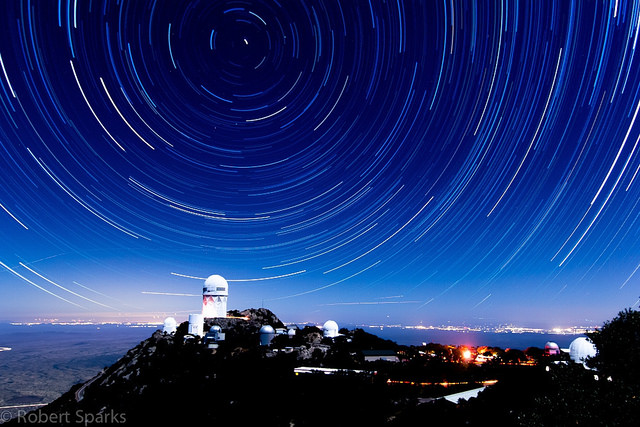
Our pal Rob Sparks said he had always wanted to try creating a star trails picture and this is his first attempt. Very nice! Of course, he had a great view of the telescopes on Kitt Peak in Arizona as a stunning foreground, (the lights of Tucson are to the right) but had to deal with a “nearly full Moon that night which illuminated the observatory and limited the exposure times,” Rob said on Flickr. “However, I am reasonably happy for a first try.”
We’re happy, too, as this is a lovely image. Thanks for sharing Rob!
You can read more details about the image on Rob’s website, The Half-Astrophysicist.
Want to get your astrophoto featured on Universe Today? Join our Flickr group or send us your images by email (this means you’re giving us permission to post them). Please explain what’s in the picture, when you took it, the equipment you used, etc.
Is Anything Left of ISON? Spacecraft Continue to Monitor Comet’s Remains
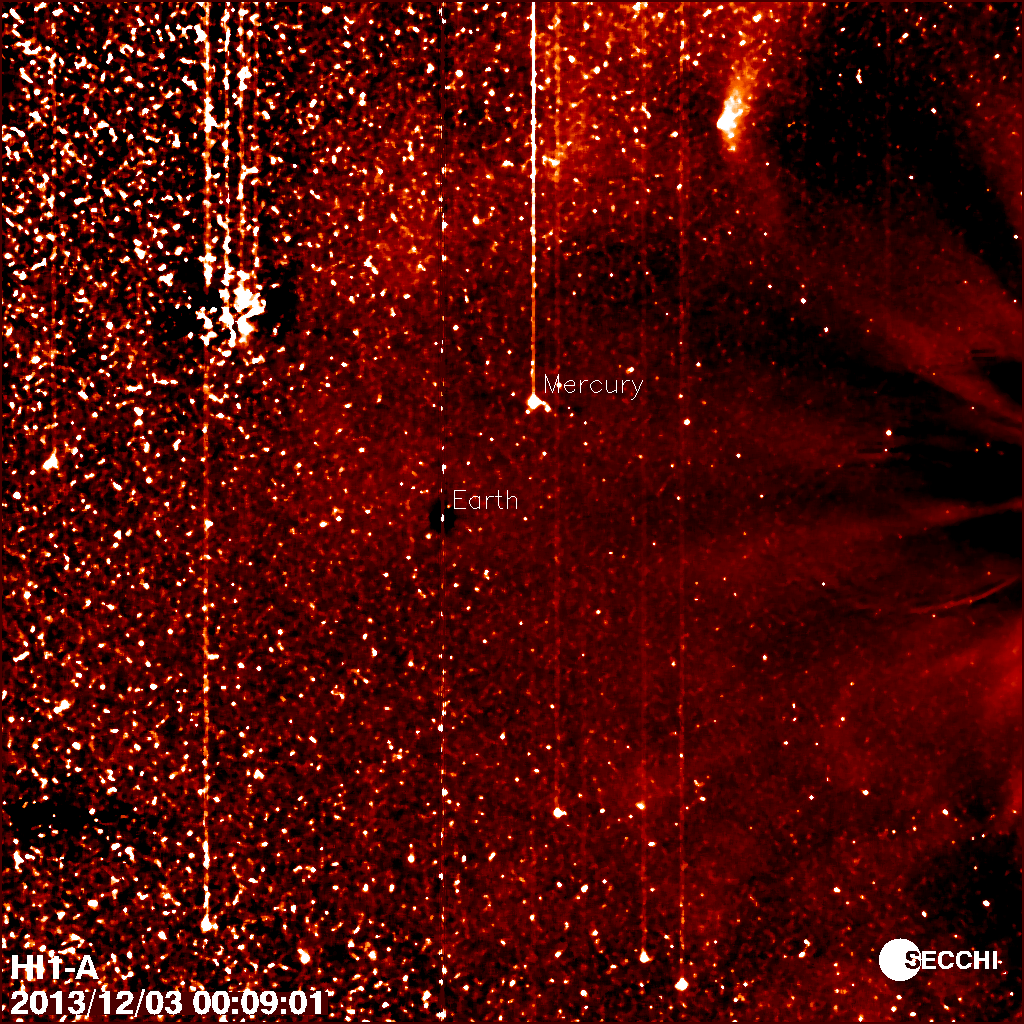
Could Comet ISON possibly still be alive? The latest high-resolution images available from the STEREO spacecraft are still showing some remains of the comet, although each day seems to show less and less activity. “If anything of ISON’s nucleus is left, it’s an inactive husk of a nucleus now,” Karl Battams from the Comet ISON Observing Campaign told Universe Today. “The comet remnant is fading fast in the STEREO data.”
Casey Lisse, also from CIOC was a bit more hopeful. In a web posting yesterday (Dec. 4) he said, “At this time, scientists are not sure how much of the comet survived intact. We may be seeing emission from rubble and debris in the comet’s trail, along its orbit, or we may be seeing the resumption of cometary activity from a sizable nucleus-sized chunk of ISON.”
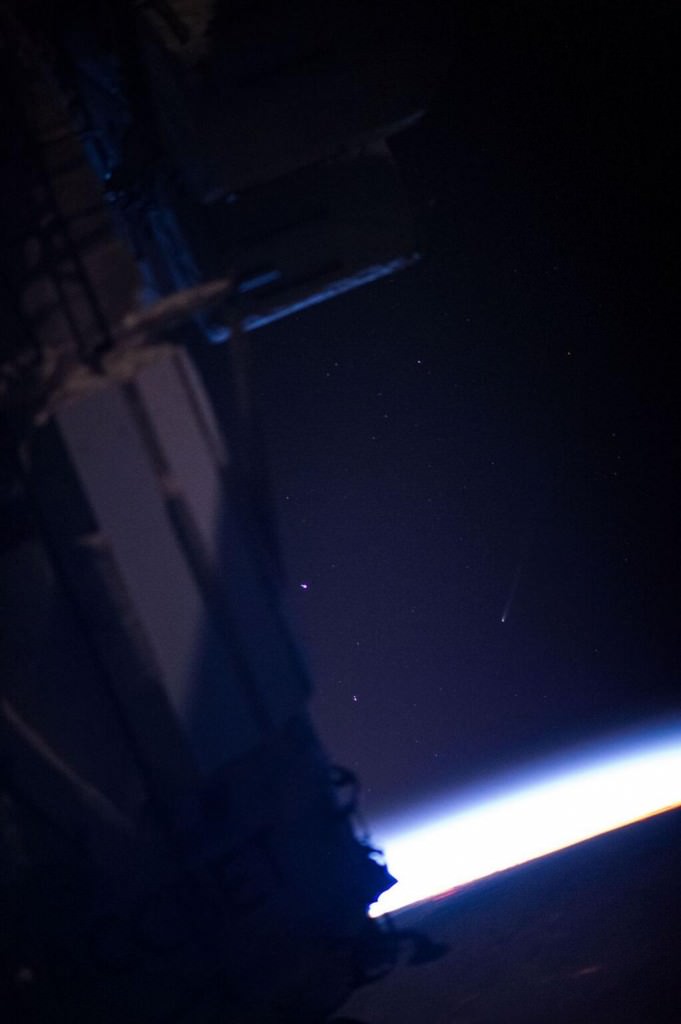
Lisse added that most astronomers agree that Comet ISON was destroyed (with greater than 90% probability of this having occurred), leaving behind small (less than 10 m radius from the original 1 km nucleus) pieces of rubble, but there could be fragments 100 meters radius or larger. This would be big enough for astronomers to study but probably not big enough to provide a nice sky display later in December that everyone was hoping for.
Here’s the schedule of events for spacecraft to study whatever is left of Comet ISON, according to Lisse:
– NASA will monitor the comet for the next several weeks. If there is nothing sizable and stable left, it will dissipate and disappear in this time, as already emitted dust leaves the vicinity. If there is still a central source of emission, even if it is very much smaller, we will see a new, much fainter coma and tail form, which currently may be overwhelmed by the dust emitted from before the disruption event.
– NASA’s STEREO spacecraft will be using their cameras to search for bright fragments throughout the week, while the NASA Infrared Telescope Facility (IRTF) in Honolulu, Hawaii will use its 3m wide telescope to detect the comet spectroscopically, the same way it did on ISON’s inbound journey. Radio telescopes around the world will also be able to tell us more about what has happened. NASA’s recently launched MAVEN spacecraft may try to observe ISON next week. By mid- to late-December NASA’s Hubble and Chandra observatories will be performing deep outer space searches for any remnants of the comet. Spitzer will also look for ISON in early 2014.
If a fragment that acts like a comet is detected, but at a much reduced level, it may be hard to see it from the Earth at the time of its closest approach on December 26, 2013.
You can find out the latest on what is going on with ISON tomorrow, Dec. 6, 2013 as the CIOC is holding a post-perihelion workshop to discuss the status of the comet. The morning sessions, live from theh Applied Physics Lab at Johns Hopkins University will be webcast from approximately 8:30 am EST to 11:30 am EST, will be available for viewing in the player below:
More details on the meeting are available here.
So far, 12 spacecraft and the International Space Station have observed and detected Comet ISON on its multi-million year journey from the Oort Cloud to the solar corona. You can find out more about the planned Hubble observations here.
Where Does Gravity Come From?
Gravity. The average person probably doesn’t think about it on a daily basis, but yet gravity affects our every move. Because of gravity, we fall down (not up), objects crash to the floor, and we don’t go flying off into space when we jump in the air. The old adage, “everything that goes up must come down” makes perfect sense to everyone because from the day we are born, we are seemingly bound to Earth’s surface due to this all-pervasive invisible force.
But physicists think about gravity all the time. To them, gravity is one of the mysteries to be solved in order to get a complete understanding of how the Universe works.
So, what is gravity and where does it come from?
To be honest, we’re not entirely sure.

We know from Isaac Newton and his law of gravitation that any two objects in the Universe exert a force of attraction on each other. This relationship is based on the mass of the two objects and the distance between them. The greater the mass of the two objects and the shorter the distance between them, the stronger the pull of the gravitational forces they exert on each other.
We also know that gravity can work in a complex system with several objects. For example, in our own Solar System, not only does the Sun exert gravity on all the planets, keeping them in their orbits, but each planet exerts a force of gravity on the Sun, as well as all the other planets, too, all to varying degrees based on the mass and distance between the bodies. And it goes beyond just our Solar System, as actually, every object that has mass in the Universe attracts every other object that has mass — again, all to varying degrees based on mass and distance.

With his theory of relativity, Albert Einstein explained how gravity is more than just a force: it is a curvature in the space-time continuum. That sounds like something straight out of science fiction, but simply put, the mass of an object causes the space around it to essentially bend and curve. This is often portrayed as a heavy ball sitting on a rubber sheet, and other smaller balls fall in towards the heavier object because the rubber sheet is warped from the heavy ball’s weight.
In reality, we can’t see curvature of space directly, but we can detect it in the motions of objects. Any object ‘caught’ in another celestial body’s gravity is affected because the space it is moving through is curved toward that object. It is similar to the way a coin would spiral down one of those penny slot cyclone machines you see at tourist shops, or the way bicycles spiral around a velodrome.

We can also see the effects of gravity on light in a phenomenon called gravitational lensing. If an object in space is massive enough – such as a large galaxy or cluster of galaxies — it can cause an otherwise straight beam of light to curve around it, creating a lensing effect.
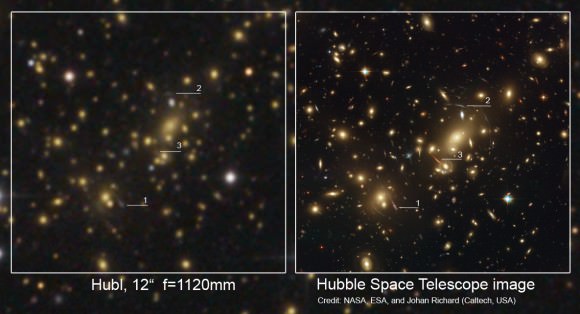
But these effects – where there are basically curves, hills and valleys in space — occur for reasons we can’t fully really explain. Besides being a characteristic of space, gravity is also a force (but it is the weakest of the four forces), and it might be a particle, too. Some scientists have proposed particles called gravitons cause objects to be attracted to one another. But gravitons have never actually been observed. Another idea is that gravitational waves are generated when an object is accelerated by an external force, but these waves have never been directly detected, either.
Our understanding of gravity breaks down at both the very small and the very big: at the level of atoms and molecules, gravity just stops working. And we can’t describe the insides of black holes and the moment of the Big Bang without the math completely falling apart.
The problem is that our understanding of both particle physics and the geometry of gravity is incomplete.
“Having gone from basically philosophical understandings of why things fall to mathematical descriptions of how things accelerate down inclines from Galileo, to Kepler’s equations describing planetary motion to Newton’s formulation of the Laws of Physics, to Einstein’s formulations of relativity, we’ve been building and building a more comprehensive view of gravity. But we’re still not complete,” said Dr. Pamela Gay. “We know that there still needs to be some way to unite quantum mechanics and gravity and actually be able to write down equations that describe the centers of black holes and the earliest moments of the Universe. But we’re not there yet.”
And so, the mystery remains … for now.
This “Minute Physics” video helps explain what we know about gravity:
We have written many articles about gravity for Universe Today. Here’s an article about gravity and antimatter, and here’s an article about the discovery of gravity. This recent article discusses how the latest research looks at quantum physics to explain gravity.
If you’d like more info on Gravity, check out The Constant Pull of Gravity: How Does It Work?, and here’s a link to Gravity on Earth Versus Gravity in Space: What’s the Difference?.
We’ve also recorded an entire episode of Astronomy Cast all about Gravity. Listen here, Episode 102: Gravity.
For further reading:
Cornell Astronomy
UT-Knoxville
Could Particle ‘Spooky Action’ Define The Nature Of Gravity?

Quantum physics is a fascinating yet complicated subject to understand, and one of the things that freaks out physics students every is the concept of entanglement. That occurs when physicists attempt to measure the state of a particle and that affects the state of another particle instantly. (In reality, the particles are in multiple states — spinning in multiple directions, for example — and can only be said to be in one state or another when they are measured.)
“Spooky action at a distance” is how Albert Einstein reportedly referred to it. Here’s the new bit about this: Julian Sonner, a senior postdoctoral researcher at the Massachusetts Institute of Technology, led research showing that when two of these quarks are created, string theory creates a wormhole linking the quarks.
According to MIT, this could help researchers better understand the link between gravity (which takes place on a large scale) to quantum mechanics (which takes place on a very tiny scale). As MIT puts it, up to now it’s been very hard for physicists to “explain gravity in quantum-mechanical terms”, giving rise to a preoccupation of coming up with a single unifying theory for the universe. No luck yet, but many people believe it exists.

“There are some hard questions of quantum gravity we still don’t understand, and we’ve been banging our heads against these problems for a long time,” Sonner stated. “We need to find the right inroads to understanding these questions.”
Quantum entanglement sounds so foreign to our experience because it appears to exceed the speed of light, which violates Einstein’s general relativity. (The speed limit is still being tested, of course, which is why scientists were so excited when it appeared particles were moving faster than light in a 2011 experiment that was later debunked due to a faulty sensor.)
Anyway, this is how the new research proceeded:
– Sonner examined the work of Juan Maldacena of the Institute for Advanced Study and Leonard Susskind of Stanford University. The physicists were looking at how entangled black holes would behave. “When the black holes were entangled, then pulled apart, the theorists found that what emerged was a wormhole — a tunnel through space-time that is thought to be held together by gravity. The idea seemed to suggest that, in the case of wormholes, gravity emerges from the more fundamental phenomenon of entangled black holes,” MIT stated.
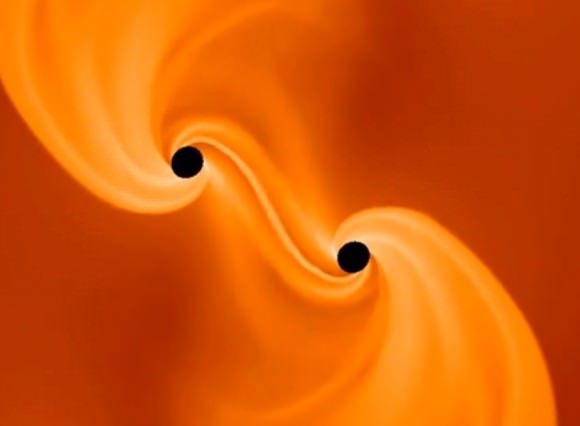
– Sonner then set about to create quarks to see if he could watch what happens when two are entangled with each other. Using an electric field, he was able to catch pairs of particles coming out of a vacuum environment with a few “transient” particles in it.
– Once he caught the particles, he mapped them in terms of space-time (four-dimensional space). Note: gravity is believed to be the fifth dimension because it can bend space-time, as you can see in these images of galaxies below.
– Sonner then tried to figure out what would happen in the fifth dimension when quarks were entangled in the fourth dimension, using a string theory concept called holographic duality. “While a hologram is a two-dimensional object, it contains all the information necessary to represent a three-dimensional view. Essentially, holographic duality is a way to derive a more complex dimension from the next lowest dimension,” MIT stated.
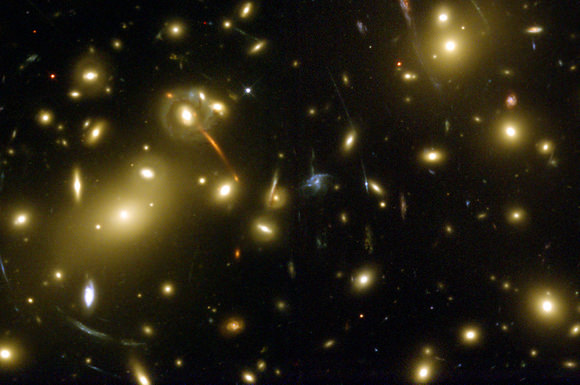
– And it was under holographic duality that Sonner found a wormhole would be created. The implication is that gravity itself may come out of entanglement of these particles, and that the bending we see in the universe would also be due to the entanglement.
“It’s the most basic representation yet that we have where entanglement gives rise to some sort of geometry,” Sonner stated. “What happens if some of this entanglement is lost, and what happens to the geometry? There are many roads that can be pursued, and in that sense, this work can turn out to be very helpful.”
You can view the research in Physical Review Letters.
Saturn’s Mysterious Hexagon Behaves Like Earth’s Ozone Hole

A raging hurricane is creating a “suck zone” at Saturn’s north pole. The handy Cassini spacecraft recently captured a bunch of images of the six-sided jet stream surrounding the storm, which mission managers then put together into an awesome animation showing the wind currents shifting. (You can see the animation below the jump.)
The feature is pretty in a picture, but NASA has a special interest because there is nothing else like this anywhere in our solar system, the agency stated. The immense storm stretches 20,000 miles (30,000 kilometers) across with winds whipping in its jet stream at 200 miles per hour (322 kilometers per hour). And despite all the turbulence, the storm is staying put at the north pole for reasons scientists are still trying to understand.
“The hexagon is just a current of air, and weather features out there that share similarities to this are notoriously turbulent and unstable,” said Andrew Ingersoll, a Cassini imaging team member at the California Institute of Technology in Pasadena. “A hurricane on Earth typically lasts a week, but this has been here for decades — and who knows — maybe centuries.”
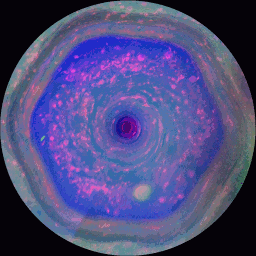
Cassini has been orbiting Saturn since 2004, but it’s only since last year that it’s been able to peer at the hexagon with much success. That’s because the angle of the sun is finally favorable to peer at the storm. This has allowed scientists, for example, to look at the types of particles inside. They discovered that the jet stream is a sort of barrier around the storm, delineating a location with a lot of small haze particles and few large haze particles. (It’s the opposite outside of the jet stream). Scientists said it looks like the Antarctic ozone hole on Earth.
“The Antarctic ozone hole forms within a region enclosed by a jet stream with similarities to the hexagon,” NASA stated.
“Wintertime conditions enable ozone-destroying chemical processes to occur, and the jet stream prevents a resupply of ozone from the outside. At Saturn, large aerosols cannot cross into the hexagonal jet stream from outside, and large aerosol particles are created when sunlight shines on the atmosphere. Only recently, with the start of Saturn’s northern spring in August 2009, did sunlight begin bathing the planet’s northern hemisphere.”
Should Cassini have enough funding to function for a few more years, scientists are eager to watch as Saturn gets to its summer solstice in 2017 and the lighting gets even better around the north pole.
NASA also held an interesting Google+ Hangout yesterday (Nov. 4) about Saturn and the Cassini mission that featured Carolyn Porco, director of the Cassini Imaging Team and the Cassini Imaging Central Laboratory for Operations (CICLOPS). The whole video below is worth a watch, but here’s a little tidbit to let you know some of what was talked about:
“If you took all the mass of Saturn’s rings and recomposed it into a moon, it would be no bigger than Enceladus, so it’s a big spectacle coming from little mass,” Porco said. “The main rings are very thin, only about 30 feet [9 meters] thick, no bigger than about 2 stories in a modern day building. Despite the fact they are about 280,000 km [174,000 miles] across.”

